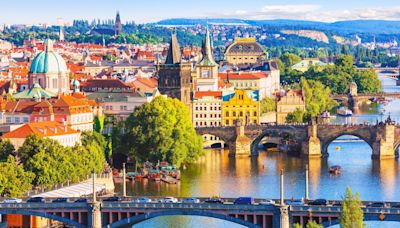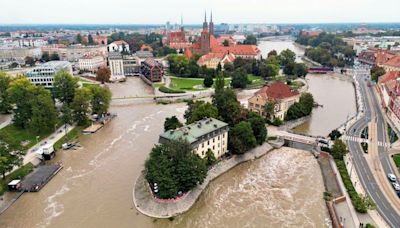Search results
Prague is a political, cultural, and economic hub of Central Europe, with a rich history and Romanesque, Gothic, Renaissance and Baroque architectures. It was the capital of the Kingdom of Bohemia and residence of several Holy Roman Emperors, most notably Charles IV (r. 1346–1378) and Rudolf II (r. 1575–1611).
- Overview
- The landscape
- The people
Prague, city, capital of the Czech Republic. Lying at the heart of Europe, it is one of the continent’s finest cities and the major Czech economic and cultural centre. The city has a rich architectural heritage that reflects both the uncertain currents of history in Bohemia and an urban life extending back more than 1,000 years.
The physical attractions and landmarks of Prague are many. Among the finest is the Charles Bridge (Karlův most), which stands astride the Vltava River. The winding course of the Vltava, with its succession of bridges and changing vistas, contrasts with the ever-present backdrop of the great castle of Hradčany (Prague Castle), which dominates the left-bank region of the city from behind massive walls set high on a hill. The narrow streets and little taverns and restaurants of the older quarters contrast with the broad sweep of Wenceslas Square and modern parks and housing developments, while the great 18th-century Baroque palaces have their own elegance and splendour. Seen from the surrounding hills, the many church towers make up a unique perspective, giving Prague its description as the “city of a hundred spires.” This architectural harmony was enhanced by post-1945 planning, which preserved the ancient core of the city as a major monument and carefully supervised all modern building. In 1992 the historic city centre was added to UNESCO’s World Heritage List.
From its original small riverside settlements, Prague has spread over its hills, up river valleys, and along riverside terraces. The Prague metropolitan area covers 192 square miles (496 square kilometres).
Britannica Quiz
World Capitals Quiz
The city’s core, with its historic buildings, bridges, and museums, is a major centre of employment and traffic congestion. Around the core is a mixed zone of industrial and residential areas, containing about half the city’s population and nearly half its jobs. Surrounding this area is the outer city development zone, and beyond this is yet another zone of development containing new industrial areas, parks and recreation areas, and sports facilities. Finally, there is a belt of agricultural land and open countryside, where farms and market gardening projects satisfy Prague’s demand for food.
The lowest point in the city is 623 feet (190 metres) above sea level, and the highest point is 1,247 feet (380 metres) on White Mountain (Bílá hora). The climate of Prague is typically mid-continental, with temperatures there averaging 67 °F (19.3 °C) in July and 31 °F (−0.6 °C) in January.
Students save 67%! Learn more about our special academic rate today.
Prague has a homogeneous population. There is a small Slovak community, but the overwhelming majority of residents are Czechs. The city has a number of demographic peculiarities stemming mainly from the effects of World War II; there are more women than men, and a sizable proportion of the female population is past the age of fertility. The natural...
Prehistory. The land where Prague came to be built has been settled since the Paleolithic Age. Several thousand years ago, trade routes connecting southern and northern Europe passed through this area, following the course of the river. From around 500 BC the Celtic tribe known as the Boii were the first inhabitants of this region known by name.
- 4,000
- Stroll Across Charles Bridge. Charles Bridge (Karlov Most) is one of the most famous pedestrian bridges in the world, connecting the Old Town to Mala Strana.
- Visit the Old Town Square. The Old Town Square (Staromestske Namesti) has been the market square for Prague since the 11th century. Now it is a landmark of the city and a popular tourist attraction.
- Watch the Hourly Show at the Astronomical Clock. The astronomical clock is a complicated mechanism that shows several different versions of time. Every hour, the clock puts on a brief show: a skeleton rings his bell, twelve apostles walk by, a rooster crows, and then the clock chimes.
- Climb the Towers of Prague. Prague is called “The Golden City of A Hundred Spires” and there is no better way to view this cityscape than from the top of its many gothic towers.
- One of the world’s largest castles can be found in Prague. The Guinness Book of World Records recognizes Prague Castle, which was founded in 880 by Prince Boivoj of the Premyslid Dynasty, as the biggest castle complex in the history of mankind.
- There is an entire wall painted in honor of John Lennon. The Lennon Wall may be found right adjacent to the French Embassy in Prague’s main business sector.
- There is rumor of a haunting bridge in Prague. Charles Bridge, Prague’s most well-known landmark, has a reputation for being haunted. Midnight is when the ghosts are said to make their appearance, according to urban legend.
- A very narrow street can be found in Prague. Located in the historic district of Mala Strana in Prague, this narrow street branches off of U Luického semináe.
Sep 12, 2024 · The first settlement at what is now Prague has been traced to the second half of the 9th century. The oldest building was Vyšehrad (hrad, “castle”), set on a commanding right-bank hill. It was followed by what was to become Hradčany, set on an equally commanding left-bank site a little downstream.
The city of Prague is commonly known as the “City of a Hundred Spires.” The highlights of Prague, Czech Republic , include gorgeous architecture, extensive history, and thriving culture have made it a popular tourist destination for decades.




